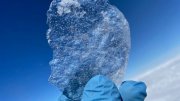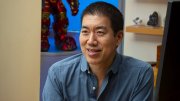Aging in the blood system can be reversed, Amy Wagers, an associate professor of stem-cell and regenerative biology, reports in the January 28 issue of Nature. The paper details findings of Wagers's investigation of how aging and tissue repair work in the body—work described in "A Hidden Youthfulness," the sidebar to the article on the state of stem-cell science in the January-February issue of Harvard Magazine.
When Wagers joined the circulation of a young mouse to that of an old mouse for her experiment, she found that the blood stem cells in the old mouse could be reawakened to repair muscle damage efficiently—the same way the process occurs in young mice. In her Nature paper, Wagers describes what is happening at the cellular level: In old mice, blood stem cells proliferate, but paradoxically, that doesn't improve their regenerative capacity. In fact, they become less effective and produce "too many inflammatory factors" and too few b-lymphocytes—a type of immune cell. Wagers discovered that the blood stem cells get their marching orders from osteoblasts, a bone-forming progenitor cell that lives in bone marrow.
The signal sent from the osteoblasts to the blood stem cells has not yet been identified, but Wagers found that osteoblasts exposed to an aged circulation or to aging itself produce more IGF-1 (insulin-like growth factor) and respond more to that factor as well, causing "detrimental changes in that cell that are subsequently communicated to blood stem cells."
Interestingly, when IGF-1 is localized in muscle, it actually enhances repair there (as dopers in professional sport have discovered); but it seems to have the opposite effect in the blood system.
The full Nature paper is off limits to non-subscribers, but an abstract is available online.








